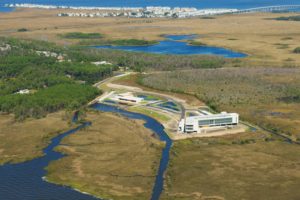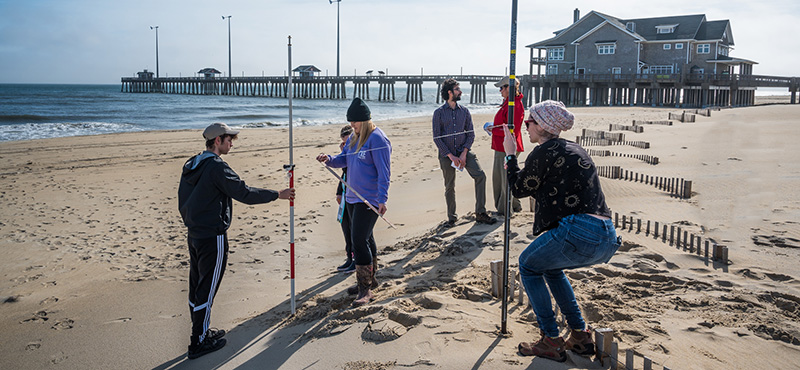The newest addition to the Department of Coastal Studies’ faculty is no stranger to the ECU Outer Banks Campus and the Coastal Studies Institute. In fact, before his recent promotion to Research Assistant Professor, Dr. Sean Charles had been a postdoctoral scholar in the Coasts and Oceans Observing Lab at CSI since 2020.
Given his childhood experiences, it should come as no surprise that Charles now studies coastal wetlands all over the world. His earliest memories include jumping from cypress trees into marshy waters, and his first “job” was catching crabs from his kayak to sell to his parents’ friends. He has always felt most at home near the marsh, and the setting has driven his curiosity from an early age.
The problems faced by coastal communities and ecosystems today, such as sea level rise and saltwater intrusion, “came to me before I even realized it,” says Charles.
After graduating from college, Charles wrote for an environmental policy and advocacy group. He also created his own business called “Backyard Farmer”, through which he helped people in his community start their own gardens. With both jobs, Charles soon felt the draw to learn more about the interaction between plants, soils, and the broader ecosystem.

He recalled that during his final semester as an undergraduate, a wetland ecology course had illustrated the central role wetlands play in the environment by providing essential ecosystem functions. Thus he reached out with questions to the professor who taught the course. Contact between the two continued and eventually turned into Charles’ master’s research at the Virginia Institute of Marine Science about the impacts of freshwater wetlands on water quality at the coast.
Charles’s thirst for knowledge couldn’t be quenched, thus he began a PhD program at Florida International University. While he loved researching the impacts of local and global environmental change on ecosystems ranging from mangroves in Everglades National Park to Antarctic zooplankton, Charles longed to be back in the salt marshes of his Mid-Atlantic home. As fate would have it, he landed on the Outer Banks at CSI- a place with no shortage of wetlands to offer. While he continues to study ecosystems regionally and internationally, understanding and conserving North Carolina’s coastal wetlands has become his focus.
Today, Charles’s research on plant-soil interactions in coastal ecosystems continues in hopes of better understanding how wetlands and their associated plants can be used to mitigate climate change and anthropogenic, or human-caused, disturbances. His work spans multiple scales, ranging from national and international collaborations- including folks from NASA- to investigate changes in wide swaths of land over 40 years to tiny, 1-meter plots in the Currituck Sound.
He, like so many others in this region, recognizes how important this diverse coastal ecosystem can be and wants to work toward enhancing coastal resilience in North Carolina. The marshes and coastal wetlands of North Carolina help mitigate impacts from large storm events; provide critical habitat for a variety of bird and fish species; and are carbon supersinks, meaning they capture and retain a significant amount of carbon dioxide from the atmosphere. In addition to their natural value, they are also sites with great cultural, recreational, and economic value in the area.
As such, many of Charles’s ongoing projects focus on restoration and preservation efforts, as well as ecological assessments. He primarily views the environment through plant communities that reflect the environmental conditions in which they exist. He uses a combination of traditional ecological field methods (botany, biogeochemistry, and soil science) combined with cutting-edge monitoring methods to assess the health of coastal wetlands. He also utilizes remote sensing tools such as drones and satellite imagery, a skillset that he says he learned “out of necessity” during the COVID-19 pandemic when fieldwork was not an option.

Through this work, he has become quite familiar with the places and people in and near the Currituck Sound, and particularly the Pine Island Audubon Sanctuary. The native plant communities found on the marsh islands in the Sanctuary play a critical role in trapping sediment. Due to their distance from Oregon Inlet and the subsequent lack of regular flooding tides and sediment deposition, wetland pockets in the Currituck Sound are especially vulnerable. Sea level rise and increasing salinity put additional stress on the native plant communities. One of Charles’ studies aims to identify which marshes in the Sound are at the highest risk, and for what reasons, in hopes of implementing successful restoration areas with the greatest chance of success. Not only does this project rely on the expertise of several scientific collaborators, but Charles values the input and local knowledge of the hunters and fishers who use the area every day and in every season.
“As scientists, it is our job not just to bring our scientific expertise and research questions, but also to listen to those that use the land to identify changes, concerns, and potential solutions that they envision,” shares Charles.
“And as scientists, we are here as a resource to help identify vulnerability, monitor environmental change and help identify, test and implement solutions that can improve and preserve the environment and improve all people’s lives. The marshes are something that we all rely on. I welcome the local knowledge and want to understand the people’s priorities for our shared ecosystems so that we can work together to improve and protect our natural environment.”
Another project Charles is helping with also considers those who use the marsh. This semester he is an instructor for the UNC Outer Banks Field Site (OBXFS) which allows students to engage in coastal research opportunities.
Prescribed burning has been historically used to shape the marsh ecosystems in Currituck to attract waterfowl, however not much is known about the overall impact this method has had on the ecosystem’s resilience and function.
This fall, Charles, his colleagues, and the OBXFS students are identifying differences in plant community composition; calculating biomass; measuring sediment accretion (or gain); and collecting water quality readings to compare the current ecosystem to those described in records kept during previous burn years. While in the field, they are also characterizing habitat use primarily for birds but also for invasive nutria. Overall, the group hopes to gain insight into marsh resilience and vulnerabilities.
“This is a unique opportunity to collaborate with both hunters and birdwatchers, not in a top-down manner as is often the case between scientists and hunters, but to work together to improve ecosystem management,” says Charles.
“Furthermore, by engaging students in research on coastal resilience in collaboration with a broad range of end-users and managers, we hope to promote cooperation and resilience across coastal communities.”
Education, outreach, and collaboration are essential to turn science into holistic ecosystem conservation.
Through his work, Charles has truly embodied many of the traits that make the Outer Banks community what it is. He is a curious problem solver who values coming together with others to overcome challenges, all the while making the Outer Banks a more resilient place.
The preceding story first appeared in the Fall 2024 edition of CoastLines.



 Based at the Coastal Studies Institute (CSI), the North Carolina Renewable Ocean Energy Program (NCROEP) advances inter-disciplinary marine energy solutions across UNC System partner colleges of engineering at NC State University, UNC Charlotte, and NC A&T University. Click on the links below for more information.
Based at the Coastal Studies Institute (CSI), the North Carolina Renewable Ocean Energy Program (NCROEP) advances inter-disciplinary marine energy solutions across UNC System partner colleges of engineering at NC State University, UNC Charlotte, and NC A&T University. Click on the links below for more information. ECU's Integrated Coastal Programs (ECU ICP) is a leader in coastal and marine research, education, and engagement. ECU ICP includes the Coastal Studies Institute, ECU's Department of Coastal Studies, and ECU Diving and Water Safety.
ECU's Integrated Coastal Programs (ECU ICP) is a leader in coastal and marine research, education, and engagement. ECU ICP includes the Coastal Studies Institute, ECU's Department of Coastal Studies, and ECU Diving and Water Safety. The ECU Outer Banks campus is home to the Coastal Studies Institute.
The ECU Outer Banks campus is home to the Coastal Studies Institute.

